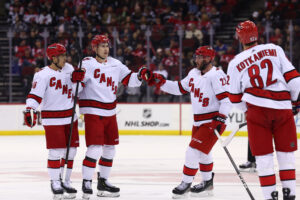The Ontario Hockey League’s return to play plan has been announced. As is, they have provided a schedule of events. No information addressing the pandemic has been provided.
The #OHL has announced Return to Play Plans for the 2020-21 season, targeting a start date of December 1.
DETAILS 📰: https://t.co/Y34czwEkYe pic.twitter.com/OaQdLaKcM1
— OntarioHockeyLeague (@OHLHockey) August 5, 2020
The Ontario Hockey League (OHL) has released its plan for a return to play. The goal is a start date of December 1, 2020. The league is aiming for a 64-game schedule, with the regular season ending on April 29, 2021. At that point, a 16-team playoff would happen. The Memorial Cup is scheduled to be hosted by either Oshawa or Sault St. Marie.
“Plan” Released
The OHL has released their tentative plan for returning to play. Last season ended abruptly. After cancelling the 2019-20 season due to the ongoing Covid-19 pandemic, the league has been hoping to return to play as quickly as possible.
In a gate driven league, the loss of ticket sales has meant major financial problems. Getting back to a semblance of normality is important to them.
“We are looking forward to getting back to playing hockey, but are committed to ensuring that we do so in a manner that is safe and healthy for our players, officials, families, billets, teams, staff, fans and the community,” – OHL Commissioner David Branch via Sportsnet
The goal of a safe return is admirable. It simply isn’t achievable in their time frame. There are major issues which have already sunk their plan. It’s hard to believe they haven’t noticed.
Enhanced Safety Protocols
The key to returning is safety. A fair evaluation of their return to play must also include a look at their enhanced safety protocols.
They don’t exist. Their plan is to figure it out later. David Branch explains:
“Health and safety is everything as we move along and have a better idea of the landscape. We will determine what we must do in terms of procedures — testing, temperature checks and protocol — if, heaven forbid, someone were to test positive (for COVID-19). We would never think of bringing a player back into startup if it wasn’t a safe environment. – Via the London Free Press (emphasis added.)
In other words, they want to figure out the safety side another day. First, they are planning to play. There are a lot of complications. For a successful return, they need to be examined.
Missing Requirements
This should not qualify as a plan. For this to have been an actual way forward, it would have had the elements needed for a successful return. Concrete actions are needed. Instead, the plan is merely a hopeful schedule. There are many key missing elements regarding things that should be under their control. It ignore reality.
Even a quick look should have provided:
- Testing protocols – players will need Covid testing. The NHL is conducting 1,500 tests a day.
- Team bubbles: will players be in a bubble with their teammates? Will this include parents and billets?
- Penalties: will teams and/or players be subject to penalties for violating pandemic related rules?
- Enhanced Safety Protocols: will players be subject to special conditions for enhanced safety?
- Travel logistics: including border issues, social distancing questions, and maintaining a safe environment.
- Enhanced Cleaning: what steps will be taken to ensure a safe working environment for minor hockey players?
The basics aren’t covered. There are more questions raised by what the OHL has done here than answers provided. No doubt the league is trying to reassure its community. They have not done it.
As players and their families are making decisions about playing this year, the league has provided no information other than a timeline. These elements are directly under their control. They have done nothing on that part. Worse, there are elements they can do nothing about.
No Crossing the Border
The OHL is an international league. This is an obstacle beyond their control.
There are 20 teams in the OHL. The Flint Firebirds and Saginaw Spirit are based in Michigan. The Erie Otters are based in Pennsylvania, where today Governor Wolf recommended there not be any school sports in the state until 2021 at the earliest.
Even if sports are allowed in those states, the border will remain closed. Per Cross-Border Institute director Bill Anderson, “no one has the appetite to touch the [border] issue until after the U.S. election.” Given Canadians are largely opposed to re-opening the border while the pandemic rages unchecked in the U.S., hockey shouldn’t be expecting to be making the crossing. The government of Canada already said no to the Toronto Blue Jays. If Rogers couldn’t get their way, David Branch won’t get an exception either.
Impacts on the Canadian Side
Most of Canada lives along the border. In a pandemic world, this is an issue. There are at least six teams which cannot have a normal season with fans in the stands.
Teams on the Canadian side of the border are in unique trouble. Even if the vast majority of the province were to return to a pre-Covid “normal,” border cities are uniquely impacted. Take Windsor for example.
People live and work in both countries. Even when the city wipes out their outbreak, a large number of citizens work in essential sectors across the border. According to Workforce Windsor Essex, over 1,000 people who live in the county work in each of the medical, scientific/professional, transportation, and education sectors. In total, they state that 6,120 people in Windsor work in the U.S.A.. Fans can’t be in the stands until their communities aren’t affected by the pandemic. This is a long way off.
Border Teams Are Sinking
The pandemic is international. Today’s Covid-19 cases in the region reflect the issue. Among the cases are a healthcare worker, and a travel related case. The “travel” cases have typically been related to logistics, which is reflected by a growing fear in the trucking industry. Windsorites are helping in the U.S. as they should, but it is holding the region back. Hockey isn’t immune.
Windsor can only wait. Similar border cities, such as Niagara Falls, are in the same situation. When you add in particularly hard hit regions beyond the border (Peel Region), the problem grows. The hockey world has to be patient, and it also needs to be safer. There are too many teams who have no clear path to operating.
From the released plan, it is not clear the OHL understands the situation they face. This is not The Secret. Wishing for something won’t make it come true.
Summing it up:
The CHL is in crisis. The OHL is currently digging a hole. Every day that passes is a day lost to implement the needed changes to safely start the season. The financial landscape for the league is very bad, and given divergent Covid realities you have to think many players are currently looking at European options.
The Ontario Hockey League’s return to play plan has been released. Unfortunately, it doesn’t address any of the obstacles regarding their return to the ice.
Main Photo:






